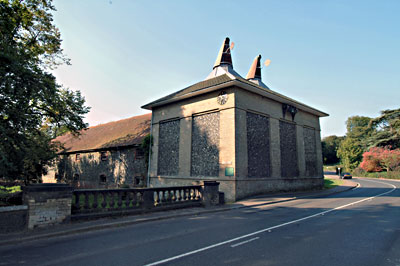 |
|
20th
September 2003
|
|
Letheringsett Brewery Mill
River Glaven |
 |
|
20th
September 2003
|
Letheringsett
Brewery mill was a later addition to the maltings and Henry Hagon's (d.1780) brewery that
William Hardy, a maltster from Coltishall, had bought on Saturday 11th November
1780, along with Letheringsett Hall and 30 acres of land for £1340,
plus £270 for a further 20 acres. The main building was substantially
built of local flint and brick with a Norfolk pantile roof. The mill
was originally to be constructed purely as a malt mill but William Hardy
saw the potential of a installing corn grinding stones despite being some
150 yards from Letheringsett_mill. The
new mill was built within the existing main building. The Brewery mill first
ground wheat to be sold as flour on 31st December 1784. By the time William Hardy snr retired in 1797 the brewery owned 25 tied houses and William Hardy jnr went on to buy an additional 9, so that by 1838 the brewery owned 34 tied houses. The business was then further expanded by William jnr., who died in 1842. On William jnr's death, his nephew William Hardy Cozens inherited the estate and in accordance with the terms of his uncle's will, he then changed his surname to Cozens-Hardy. William Cozens-Hardy died in April 1895 and the firm of W. H. Cozens-Hardy and Son was bought by Morgan & Co in 1896. |
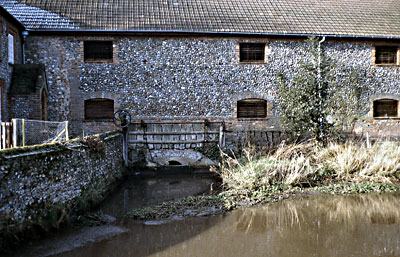 |
|
Wheelrace
sluice 4th February 1983
|
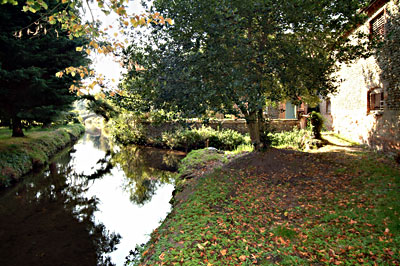 |
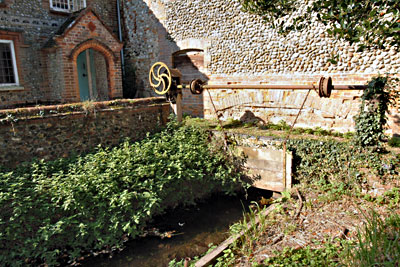 |
|
The
cut from the Glaven to the Brewery 20th Sept 2003
|
Wheelrace
sluice 20th September 2003 |
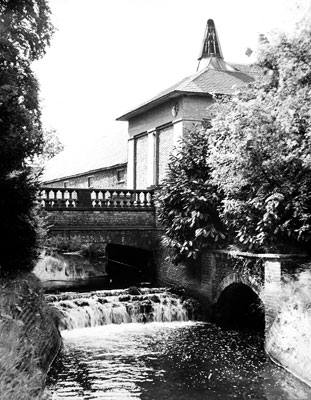 |
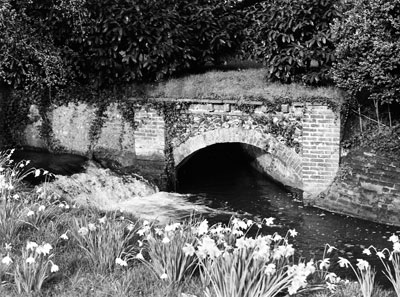 |
|
Tailrace rejoining the Glaven - 1952 |
Tailrace tunnel April 1998 |
| William Hardy snr. was originally a Yorkshire born excise officer posted to Norfolk, who married Mary Raven at Whissonsett in 1765. Mary was born in Whissonsett in November 1733 and was the daughter of Robert Raven and his wife Mary (née Fox). |
|
William Hardy had a wherry constructed for the transport of goods to and from his property at Coltishall. |
|
Nov 11 Sat. 1780 Mr Hardy went with Brot. Natt from Whissonsett to Letheringsett and looked over Hagon's Brewing Office then went to Holt to attend the sale. Bought the office with 30 acres of Land for £1340 and 20 acres of land for £270 , came home even 10. |
| Not long after
moving to Letheringsett William Hardy decided to use the River Glaven
to provide water power for his brewery - the malt mill and pumps probably
being driven by horses previously. The brewery was not more than 150 yards
below Letheringsett_water_mill and therefore there were problems as to how to secure
sufficient head of water to drive a waterwheel in the brewery without
impeding the flow of water from the corn mill upstream. |
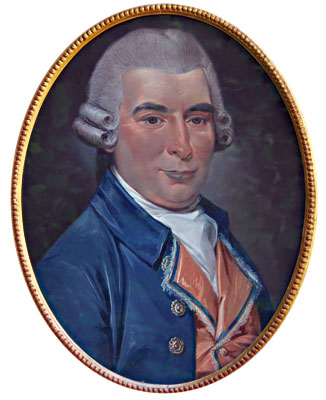 |
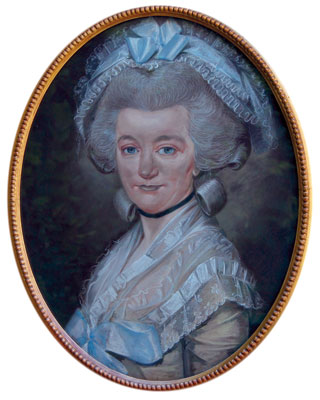 |
|
William Hardy aged 53 |
Mary Hardy aged 51 |
both painted by Huguier in 1785, from the Cozens-Hardy Collection |
|
|
William Hardy vs. Richard Rouse |
Tuesday 15th
January 1782: A fine day. 2 millwrights began to remove the malt mill. 23rd February 1783: A fine day, all went to our church afternoon. Mr. Burrell preached. A Mr. Baker from Borrough and Mr. Bliss and Edm. Beck came even 5 to see if they could contrive our malt mill to go by water. Monday 12th January 1784: 3 mill wrights began the mill after levels had been taken. Monday 8th March 1784: A very rainy day and rough wind. 4 millwrights at work, pulled down the malt mill. A very great flood in the even broke down dams and did some damage. Wednesday 17th March 1784: the millwrights got the water well down. Wednesday 24th March 1784: 4 mill wrights at work night and day Thursday 25th March 1784: Mr. Hardy at home all day, sett the water mill a going. Mr. Burrell, Mr. Bensly Mar Baker, Mr. Mathews, Mr Bolton and Mr Myles drank drank tea and supt (as written) and about 30 workmen. Mr. Henry Goggs, R. Raven and Raven Hardy came. By Quarter Day only finishing touches were left and by the next day the water mill was going. William Hardy then decided, as things were going so well, that he would extend the use of the waterwheel from malt to wheat. Richard Rouse, still the corn miller, saw the competition coming and cut a channel for the river across his meadow. On New Years Eve, Hardy started grinding wheat. The threat from Rouse caused Hardy to divert the stream by Little Thornage so that it flowed into the brewery yard and became a supplement. Friday 20th August: Wm. FREARY brought some French Burrs from Stalham Saturday 11th December 1784: Our Corn Mill sett to work Monday 27th December 1784: A slow thaw. Rouse began to cut a channel for the river across his meadow. Wednesday 29th December 1784: Rouse left of cutting across his meadow. Friday 31st December 1784: Grinding began, grinding for sale, first wheat ground Wednesday 16th March 1785: Wm. went to Barningham mill after to git a last of wheat cut. Sunday 8th January 1786: Mr. Rouse let the water into T. Lound's meadow. A great deal of rain in the night. Monday 9th January 1786: Mr. Burrell gave Rouse notice not to set foot on Lounds premises on any acct. Monday 16th January 1786: Mr. Lound came in the even. shewed Mr. Hardy a letter from Rouse begging him to give him leave to make up the Bank next the river. Tuesday 17th January 1786: Lown came abt. noon shewed us a notice to forwarn Rouse from coming upon his premises to stop the breach in the Bank on any pretention whatever. Friday 20th January 1786: Mr. Rouse threatened Mr. Burrell to make up the Bank, in spite of him. Sent King to Mr. Burrell and Lound to ensnare them. Thursday 26th January 1786: Mr. Rouse attempted to make up the Bank. Mr. John Burrell Junr. prevented them. He drank tea and Supt here. Sunday 30th April 1786: Mr. Rouse caused the breach in Mr. Burrell's Bank to be filled up in the night or early this morning. Mr. Burrell had it opened again. Saturday 6th May 1786: Rouse served writs on Mr. Burrell, our Wm. & several persons in town on acct of Mr. Burrell opening the cut that he had stopped up in the meadow. Monday 8th May 1786: Mr. Hardy & Mr. Burrell went to Dereham m 6 in Mr. Sheppard's Postchaise to speak to Lawyer Crisp, concerning the suit with Rouse. Friday 12th May 1786: Mr. Johnson of Clay, drank tea here afternoon, signed leases for Weybourne Public House. J. Burrell drank tea at Rouses, came to an agreement for an accomidation about the cut. Friday 6th October 1786: Recd. a supenea to appear at Norwich in a trial between J. Burrell and Richard Rouse. It was given favour of Rouse with £ 90 damages. Tuesday 10th October 1786: Thos. Newman took T. Lound's farm. Tuesday 11th March 1788: Starling, the miller came to let himself Mr. Hardy and he did not agree. Mary Hardy's diary |
|
Flour from the mill was eventually sold as far afield as Newcastle. |
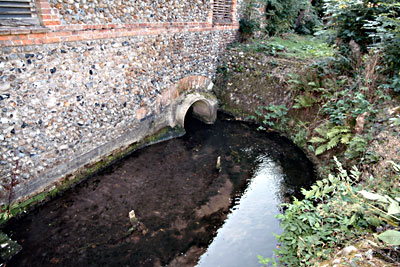 |
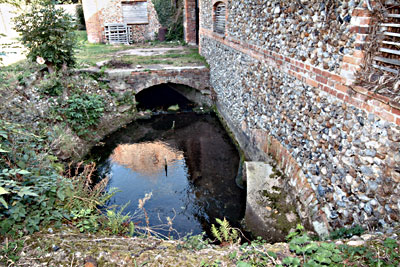 |
|
The headrace and original brick arch 20th Sept 2003
|
The
underground wheelrace channel 20th September 2003 |
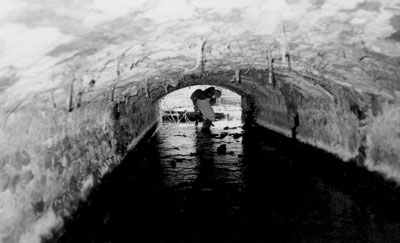 |
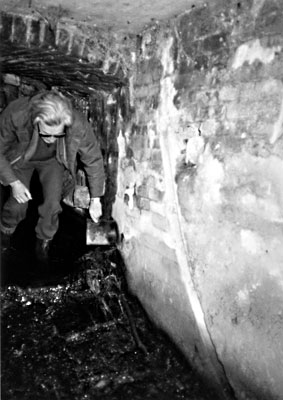 |
|
Christopher Bird at the upstream end of the wheelrace tunnel February 1989 |
Industrial Archaeologist David Durst beside waterwheel marks in February 1989 |
|
Soon after my great-great-grandfather came to this parish in 1781
as the purchaser of the dwelling house (now the Hall) a small brewery
and 50 acres of land he determined to make use of water power for his
malting business and to provide pumped household water. He called in the
services of Mr. Baker of Burgh_Mills near Aylsham
"to contrive our malt mill to go by water" as his wife recorded
in her diary. The problem was this:- the Domesday mill 150 yards upstream
and in another ownership derived its power from a head of water in a mill
dam. For the malt mill wheel a dam was impossible as it would have held
up the outflow from the other mill. Accordingly the only course was to
deepen the river below the wheel to be erected and this accounts for the
waterfall just north of the road bridge. The same diary states "With
five millwrights at work night and day they set the mill agoing"
on Lady Day 1784. |
|
Of William
Hardy jnr... |
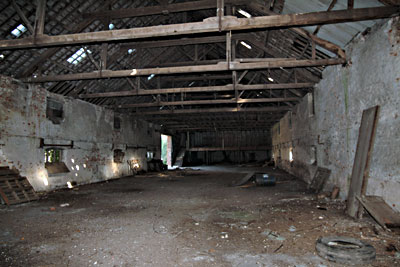 |
|
Interior
of the malthouse 20th September 2003 |
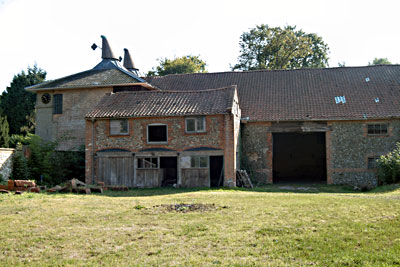 |
The maltings and brewery complex September 2003 |
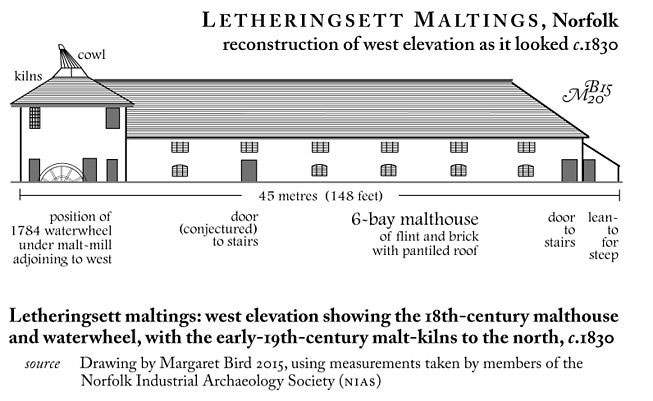 |
The site of the mill was inside the maltings complex before the fire of April 1936. |
|
According to Basil Cozens-Hardy there are or have been 3 water wheels, 11 sluices, 1 turbine, 5 hydraulic rams, 2 fountains, 5 cascades, 3 piped or culvert siphons under roads, a reservoir, an artificial lake and 6 bridges. |
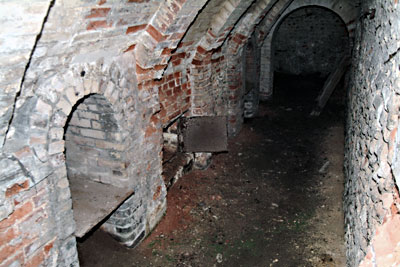 |
|
The
maltings kiln furnaces 20 September 2003
|
|
A horizontal turbine was also used on the Cozens Hardy Estate on the opposite side of the road to the north. |
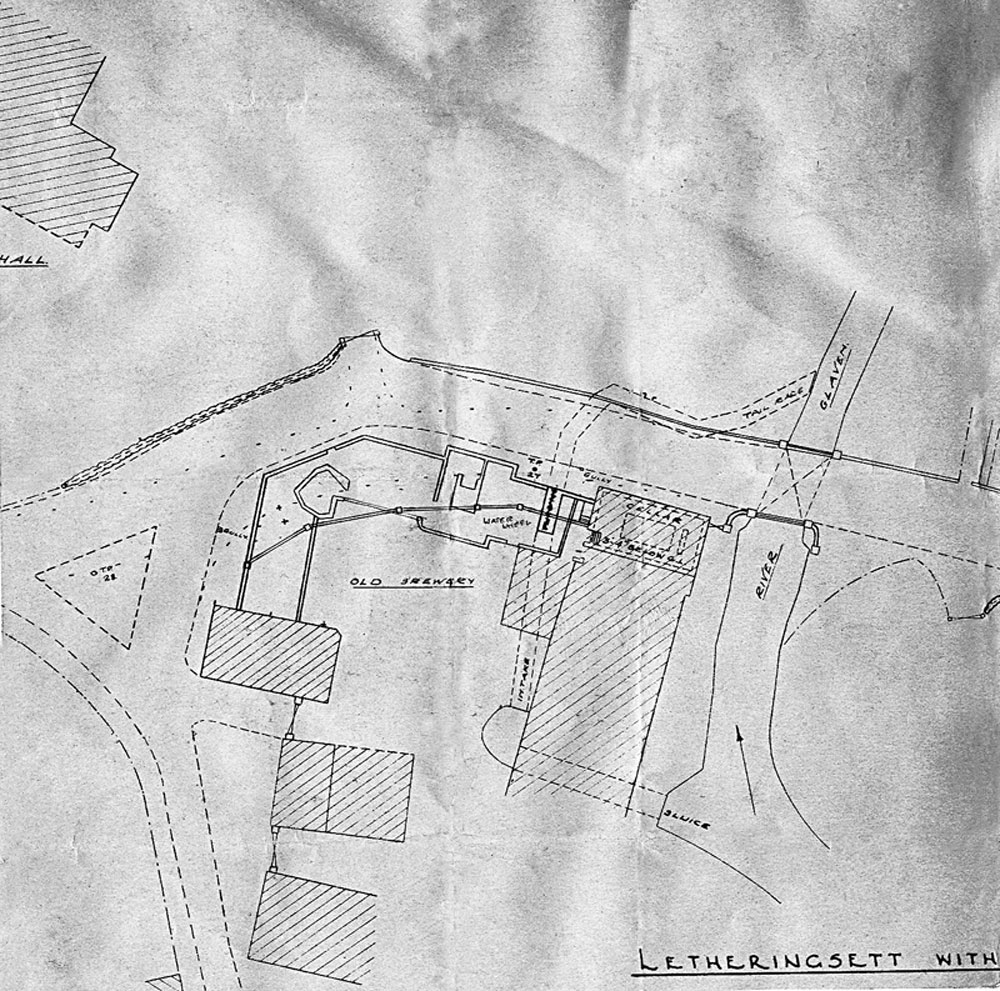 |
|
Estate map 1935 |
The long-disused Letheringsett maltings and brewery, from a plan originally of 1935, just before the fire of April 1936. The malt-kilns front the main road; the brewery occupies the north and north-west frontages. The sluice south-east of the malthouse is shown, controlling the flow along the channel which runs north to the waterwheel ('turbine') tunnel under the road and rejoins the Glaven downstream of the road bridge at the point marked 'tail race'. The waterwheel tunnel built by William Hardy 1783-84 had to bypass the cellars under the malt-kilns, which may be why there is a sharp bend before it re-enters the Glaven north of the road bridge of 1818, still in use today. Basil Cozens-Hardy has crossed out the word 'turbine' and pencilled 'waterwheel' against the site of the wheel, which in 1936 had become a charred skeleton. A proposed new road line has been added after the fire, when the local authority proposed to slice off the blind, hazardous north-west corner. The new line is imposed on the plan as a wall running west from the malt-kilns to near the tun room (the most northern of the buildings along the western range). The road was improved as shown on the plan, and today's A148, the Cromer to King's Lynn road, follows the course drawn here. Until 1808 the King's Head stood, gable end to the road, roughly where the grassy triangle is shown facing the Hardys' house, Letheringsett Hall, which is partially depicted. Margaret Bird, The Diary of Mary Hardy Vol. II - April 2013 |
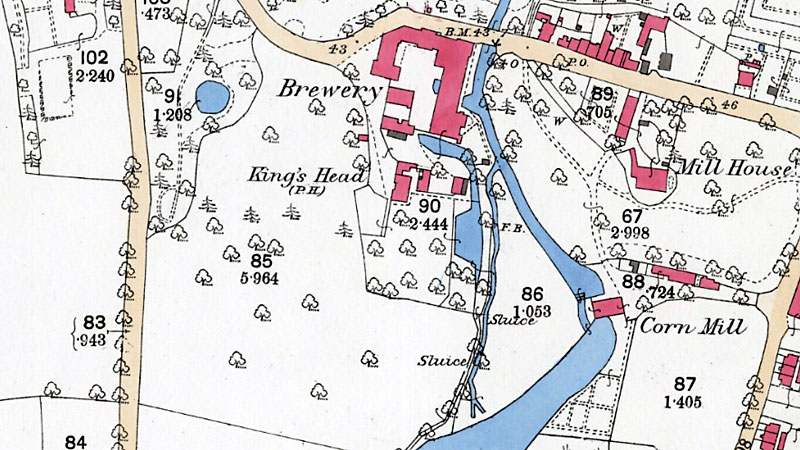 |
O. S. 25" Map 1886 (not to scale) |
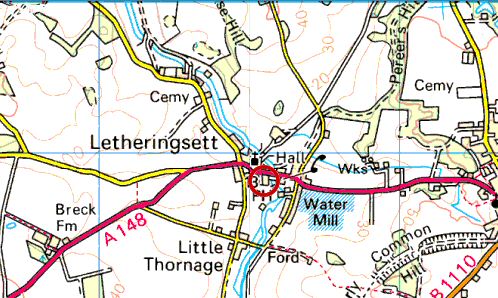 |
|
O.S. Map 2005 Image reproduced under licence from Ordnance Survey |
|
1781: William
Hardy bought the maltings and brewery along with Letheringsett Hall and
50 acres of land |
If you have any memories, anecdotes or photos please let us know and we may be able to use them to update the site. By all means telephone 07836 675369 or
|
| Nat Grid Ref TG06103880 | Copyright © Jonathan Neville 2003 |